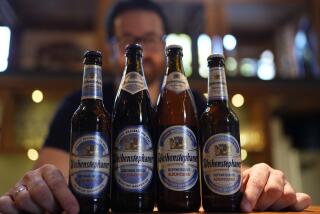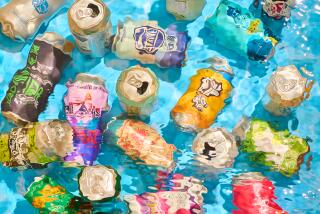Beer : A Little Respect, Please, for American Beer
- Share via
American beer, in all its foamy manifestations, has arrived. While the stereotypical good old boys may still linger over a six-pack on the porch, beer, following the trail blazed by fine wine, is being taken seriously by aficionados of the good life. These days, even the mega-brewers feel compelled to enter the “gourmet” segment of the market.
“America has a great brewing tradition,” says Jim Koch (pronounced Cook), a sixth-generation brewmaster, who launched the Boston Beer Co. and its Samuel Adams Boston Lager in 1985.
But until recently, few major American brewers tried to emulate the complexly flavored ales, stouts and porters that are so much a part of the beer-drinking tradition in Europe. Instead, mainstream American breweries, by and large, specialize in clean, light (many say, bland) beers that are easy to drink.
Koch is one of several brewers--Fritz Maytag at Anchor Steam and Sierra Nevada Brewery’s Ken Grossman and Paul Kamusi are others--credited with challenging that formula. “American brewers can make a beer that is better than any other in the world,” Koch says, “just like Californians have proven with their top wines.”
Koch named his beer after Samuel Adams, the Revolutionary-era patriot, because he wanted to establish what he calls American beer independence. “I wanted to change the way we think about our own beer,” he says.
That change coincided with the revolution in American cooking that began in the late ‘70s and brought the world California and other regional cuisines.
“Wine came first, then coffee went through the loop, then local bakeries making wonderful, hand-crafted loaves of bread. Now beer is entering that cycle,” says microbrewer-turned-publisher Bill Owens. “The difference is that beer is so gigantic and the culture is so enormous . . . . Hey, once you try cappuccino, you never go back to instant coffee. And once you drink these wonderful beers, you just don’t go back.”
Today, there are some 400 brew pubs and/or microbreweries in the United States--most heeding the battle cry for a more flavorful product--but 10 years ago there were almost none. The first U.S. microbrewery (the now-defunct New Albion in Sonoma County) wasn’t founded until 1977, and the first U.S. brew pub (Grant’s Brewery Pub in Yakima, Wash.) opened in 1982. Owens just celebrated the tenth anniversary of his Buffalo Bill’s Brewpub in Hayward, south of Oakland.
“Brew pubs, regional breweries and even some of the big brewers are playing the keyboards of flavor, color and aroma,” Owens says. “Today, beer ranges in color from red to black to brown; this kind of selection wasn’t available before. I think the rainbow flavors and colors have really caught Americans’ fancy.”
Even the politicians have taken notice.
Legislation sponsored by 41 congressmen proposes that Oct. 3 through Oct. 10 be designated “Great American Beer Week” in recognition of the “economic, environmental and ‘good works’ contributions of the industry.”
The gesture was aimed more at deflecting moves by the Clinton Administration to raise federal taxes on beer, but some consider it a sign of how far the image of beer has progressed.
Consumers have become more knowledgeable about the beverage, and brewers have vastly improved their skills and products.
“People,” Owen says, “are more responsible about drinking today, and take time to study and appreciate the complex brews available.” This is evidenced by the proliferation of ales, stouts, porters, wheat beers, fruit beers and special seasonal beers now on the market.
The beer business--both domestic and import--generates $35 billion in sales annually in the United States from an estimated 85 million consumers. But domestic sales are down overall, and the stagnant economy isn’t helping. The bright spot on the scene: the growth of the American super-premiums, defined as six-packs priced at $5 and up. Super-premium beers now comprise about 3% of the total beer market and Owens predicts the figure will jump to 8% within 24 months. National distribution of several super-premium city beers, such as Anchor Steam from San Francisco, is a big factor.
Major breweries, which had previously conceded the high end of the market to European imports, have expanded their product lines to incorporate super-premiums such as Miller Reserve Amber Ale, Strohs Augsburger Bock, Coors Winterfest, Coors Killian’s Red and Anheuser Busch’s Michelob Classic Dark. This is seen as the most promising way for companies to capture greater shares of a static market.
Still, some analysts feel the major companies contributed to the reputation of beer as a lowest-common-denominator beverage, partly via their television commercials. Remember the dog that serves as beer fetcher? The ‘Norm’ character from “Cheers”--George Wendt--insisting on a can of cheap beer at a fancy restaurant? Lawyer-roping rodeo? The Swedish bikini team? Why ask Why?
“The bigger American brewers have felt the need to present beer as a convenience product that comes in a can,” writes beer expert Michael Jackson in the premiere issue of Owens’ new Beer: The Magazine. “As their product has been taken farther away from its heritage, with the nonsense of being deemed Light, Dry and now Clear, it has been made to look like a soft drink. I do not for one moment believe that the national brewers intend to deceive or are intentionally dishonest or irresponsible. I just wonder whether they have ever thought about the possibility that their own policies might put them out of business.”
Next week, Anheuser Busch is set to introduce its newest upscale effort, Budweiser Ice Draft, in California and 12 other Western states. Ice beer, first introduced in Canada, requires taking the brewing process to 28 degrees, or to the point where ice crystals form. The beer is then placed in “ultra-cold” storage for several days, filtered and packaged. The process is supposed to result in a richer, smoother taste.
August A. Busch III, chairman and president of Anheuser-Busch Companies, says that Ice Draft is part of the company’s continuing plans to introduce new premium brands. In 1994, he adds, the company plans to market what he calls a “major new product.”
Koch applauds the move by the big three--Anheuser Busch, Miller Brewing Co. and Coors Brewing Co.--to produce super-premium beers because he believes they are helping funnel consumers his way.
“People don’t switch from light beer to Samuel Adams in one jump,” Koch says. “More likely, they move from a mass-market beer to say, Miller Reserve or Coors’ Killian’s Red, and then will take the next step to Samuel Adams.”
Koch makes his American beer using the traditional four ingredients mandated by Bavarian law for German beers: water, hops, yeast and malted barley. Koch uses European hops and American malted barley, claiming this blend of ingredients makes a great beer.
“I’m after quality, not just patriotism,” he says. “Patriotism is the last refuge of a scoundrel and the last refuge of a bad beer.”
More to Read
Eat your way across L.A.
Get our weekly Tasting Notes newsletter for reviews, news and more.
You may occasionally receive promotional content from the Los Angeles Times.










